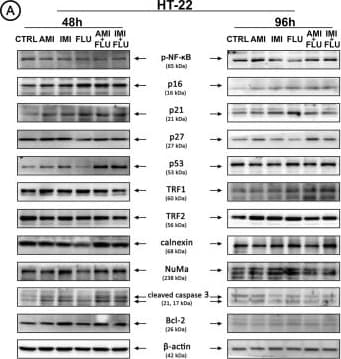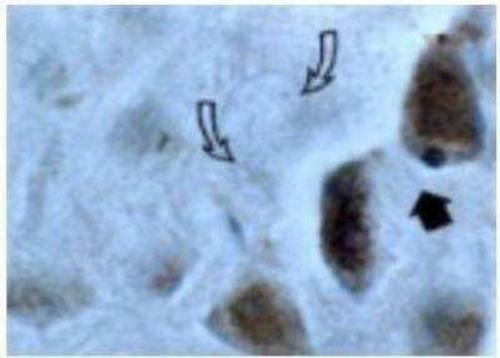Caspase 3 (CASP3) Rabbit Polyclonal Antibody
CAT#: TA336323
Rabbit Polyclonal active/cleaved Caspase 3 Antibody
Need it in bulk or conjugated?
Get a free quote
CNY 4,655.00
| Cited in 1 publication. |
CNY 300.00
CNY 1,430.00
CNY 2,900.00
CNY 3,080.00
CNY 9,998.00
CNY 3,080.00
Specifications
| Product Data | |
| Applications | FC, ICC/IF, IHC, Immunoblotting, IP, WB |
| Recommend Dilution | Flow (Intracellular), Immunohistochemistry-Frozen, Flow Cytometry, Immunoblotting, Immunocytochemistry/ Immunofluorescence, Western Blot: 1:1000-1:2000, Immunohistochemistry-Paraffin: 1:1000-1:5000, Immunoprecipitation: 1:50-1:200, Immunohistochemistry |
| Reactivity | Human, Mouse, Rat, Canine, Gerbil |
| Host | Rabbit |
| Clonality | Polyclonal |
| Immunogen | Recombinant catalytically active human caspase-3 protein was used as immunogen. |
| Formulation | Store at -20C. Avoid freeze-thaw cycles. |
| Concentration | lot specific |
| Purification | Whole antisera |
| Conjugation | Unconjugated |
| Storage Condition | Store at -20°C as received. |
| Gene Name | caspase 3 |
| Database Link | |
| Background | Apoptosis, or programmed cell death, is a common property of all multicellular organisms. The current dogma of apoptosis suggests that the components of the core cell-death machinery are integral to cells and widely conserved across species. Caspases, a family of cysteinyl aspartate-specific proteases, are integral components of the cell death machinery (reviewed in Siegal, 2006; and Lavrik et al, 2005). They play a central role in the initiation and execution of apoptotic cell death and in inflammation. Caspases are typically divided into 3 major groups, depending on the structure of their prodomain and their function. Group 1: inflammatory caspases (caspases 1, 4, 5, 11, 12, 14). Group II: initiator of apoptosis caspases (caspases 2, 8, 9). Group II: effector caspases (caspases 3, 6, 7). Caspases are synthesized as zymogens (inactive pro enzyme precursors which require a biochemical change to become active enzymes) with an N-terminal prodomain of variable length followed by a large subunit (p20) and a small subunit (p10). Caspases are activated through proteolytic cleavage at specific asparagine residues that are located within the prodomain, the p10, and p20 subunits. Activation results in the generation of mature active caspases that consist of the heterotetramer p20-p10. Active caspases mediate cell death and inflammation through cleavage of particular cellular substrates that are involved in these processes. The Active/Cleaved Caspase-3 polyclonal antisera recognizes the large (~14-21 kDa) and small (~10 kDa) subunits of active/cleaved caspase-3. Whereas the antisera has a strong preference for active/cleaved caspase-3, in some cell or tissue systems or techniques the antisera may also recognize the proform of caspase-3 (~32 kDa). |
| Synonyms | CPP32; CPP32B; SCA-1 |
| Note | Preferentially detects active caspase-3 (large subunit: ~14-21 kDa, and small subunit: ~10 kDa). However, it may also detect pro-caspase-3 (~32 kDa) in some cell or tissue systems. Nuclear immunostaining of caspase-3 is considered be an indication of active/cleaved caspase-3. Use in Flow Intracellular reported in scientific literature (PMID 24804954) |
| Reference Data | |
| Protein Families | Druggable Genome, ES Cell Differentiation/IPS, Protease |
| Protein Pathways | Alzheimer's disease, Amyotrophic lateral sclerosis (ALS), Apoptosis, Colorectal cancer, Epithelial cell signaling in Helicobacter pylori infection, Huntington's disease, MAPK signaling pathway, Natural killer cell mediated cytotoxicity, p53 signaling pathway, Parkinson's disease, Pathways in cancer, Viral myocarditis |
Citations (1)
| The use of this Antibodies has been cited in the following citations: |
|---|
|
HBO treatment enhances motor function and modulates pain development after sciatic nerve injury via protection the mitochondrial function
,null,
Journal of Translational Medicine
,PubMed ID 37582750
[CASP3]
|
Documents
| Product Manuals |
| FAQs |
| SDS |
Resources
| 抗体相关资料 |
其它Caspase 3产品


 United States
United States
 Germany
Germany
 Japan
Japan
 United Kingdom
United Kingdom
 China
China



